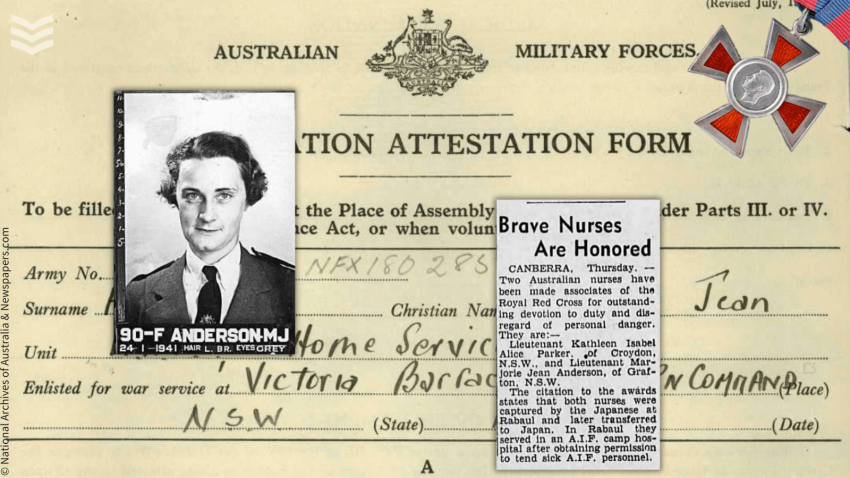Nurse. Prisoner. Survivor. This is the story of Marjory Jean Anderson, who displayed incredible courage, devotion and bravery during the Second World War. Marjory’s is just one of many stories waiting to be discovered when researching military nurses.
Japan enters the war
Japan’s attack on Pearl Harbour on 7 December 1941 drastically impacted the course of WWII. It brought the United States into the conflict and kickstarted the war in the Far East and Pacific. Soon, British and Allied territories succumbed to the fast and aggressive Japanese advance in the region. Guam, Wake Island, and Hong Kong fell in December, followed by the Philippines, the Dutch East Indies (Indonesia), Malaya, Singapore, and Burma in the first half of 1942.
For Australians, this brought the war much closer to home, and there was a fear that Australian territories, and even Australia itself, could be under threat from Japanese expansion. This fear was realised in January 1942 when Japan turned its attention to Rabaul. Rabaul is located on the island of New Britain, north of Australia. At the time, it was part of the Australian Mandate Territory of New Guinea.
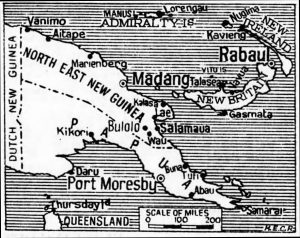
The Japanese began bombing Rabaul in early January 1942, paving the way for their invasion on the 23rd, which saw Rabaul fall on the same day. The Japanese invasion force outnumbered and overwhelmed the defenders, known as Lark Force. Lark Force was largely made up of members of the 2/22nd Battalion Australian Imperial Force (AIF) and the New Guinea Volunteer Rifles. It also included six army nurses from the Australian Army Nursing Service (AANS), one of whom was Marjory Jean Anderson.
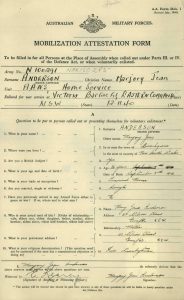
Marjory volunteers for service
Marjory was born in Brushgrove, New South Wales (NSW) in 1914, and her family lived in Grafton, where she attended Grafton High School. A qualified nurse in civilian life, she trained at Sydney Hospital and worked at the Royal North Shore Hospital in St. Leonard’s, Sydney, before the war.
Marjory’s service record offered valuable insight into her military service and is a crucial source for researching military nurses. Marjory joined the AANS as a Staff Nurse at Victoria Barracks, NSW, in November 1940. The Australian Army Nursing Service was formed in 1902 and provided a pool of trained, volunteer civilian nurses who could be called up during a national emergency.
After a stint of service at home, Marjory departed Australia on 18 April 1941. Her destination was Rabaul, and she was joined by the 2/22nd Battalion AIF, arriving on 26 April. They would form the garrison known as ‘Lark Force’ to protect against future Japanese invasion, which we know was less than a year away. Marjory was hospitalised with sickness from 28 July to 7 August 1941, perhaps owing to the climate or conditions on the island.
When Rabaul fell on 23 January 1942, authorities in Australia were not clear on the exact whereabouts of many of the island’s defenders. Some of Lark Force escaped capture and made it back to Australia. For others like Marjory, details of their fate would slowly trickle back home. This is exemplified in her service record, which notes on 25 January 1942 that she was ‘posted missing, believed POW’, and ‘reported missing in action.’
Details in Marjory’s service record are limited, as many service records can be when recording the movements and whereabouts of POWs, particularly in the Far East during WWII. A later entry reveals the following:
‘POW. Previously reported missing believed prisoner of war now reported POW interned Kanagawi [sic Kanagawa] Prefectural Camp C1 No2 (Nakawadacho Totsukaku, Yokohama).
This confirmation appears to have arrived in August 1945, following the end of the war, when it was easier to ascertain the fate of certain captured personnel.
What happened to Marjory after Rabaul fell?
On 5 March 1942, the Macleay Argus, based in Kempsey, NSW, published an article under the title ‘Clarence Nurses. Prisoners at Rabaul’. Newspapers are a great resource for researching the exploits of our military ancestors, particularly during both World Wars and can’t be overlooked when researching military nurses.
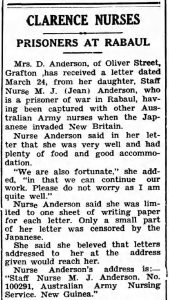
The Macleay Argus reported that Marjory was a prisoner of war in Rabaul following the Japanese invasion of New Britain and that Marjory’s mother Mrs. D. Anderson of Grafton, had received a letter from her daughter dated 24 March 1942. Limited to one sheet of writing paper for each letter, Marjory stated that she was ‘very well and had plenty of food and good accommodation.’
‘”We are also fortunate,” she added, “in that we can continue our work. Please do not worry as I am quite well.”’
Contrasting with the upbeat notes in the letter home to her mother, Marjory offered the following insight into life as a prisoner in Rabaul in the publication Captives: Australian Army Nurses in Japanese Prison Camps, by Catherine Kenny:
‘”We knew having seen it in the hospital, even in the short time after capture and whilst we were still caring for our own soldiers, there were quite a few of those boys who turned their faces to the wall and just died, and we knew what had happened to those boys and it wasn’t going to happen to us.”’
Further information about Marjory was gleaned from the University of Melbourne’s Missing, Wounded and Prisoner of War Enquiry Cards, available through the university’s website.
According to her card in the collection, Marjory’s sister Mrs. M. Giovanelli contacted the Australian Red Cross, enquiring about her sister’s whereabouts. Marjory’s card notes on 12 May 1942:
‘…heard from escapee from Rabaul that nurses were taken to concentration camp about 25 miles from Rabaul.’
The card reiterates that Marjory was an inmate of Kanagawa Prefectural Camp, confirmed in August 1945. The long wait for news must have been agonising for Marjory’s family.
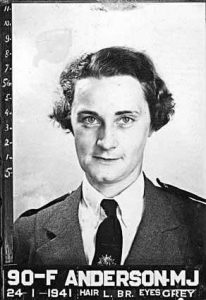
Repatriation
On 15 August, Japan’s Emperor Hirohito publically announced his country’s surrender in the wake of two atomic bomb attacks on Hiroshima and Nagasaki. The formal surrender was signed on 2 September.
Marjory’s service record notes that on 31 August 1945, she was ‘Recovered from Japanese at Totsuki [sic Totsukaku].’
On 3 September, Marjory was evacuated to the United States Hospital in Okinawa. Her service record declares ‘diagnosis not stated’, but her admission to the hospital is likely to have been linked to the conditions she endured as a POW.
After receiving treatment, Marjory set off from Okinawa in a Liberator bomber, landing in Darwin on 20 September 1945, via Manila, in the Philippines. Travelling with a contingent of 20 repatriated Australian prisoners of war, it was the first time she had been on Australian soil in almost four-and-a-half years.
The following day Marjory was admitted to 113th Australian General Hospital, known today as Concord Repatriation General Hospital. Located in the Concord suburb of Sydney, the hospital was established in 1941, treating returned servicemen and women. Discharge on 18 October, Marjory was back in Concord Hospital on 27 October before being discharged on 6 November. She was then admitted to the 3rd Australian Women’s Hospital on 2 December, also located in Concord, and left on 20 December.
Nearing the end of her service, Marjory, now a Captain, was allotted regimental duties at 101 Australian General Hospital in January 1946. The brutal conditions Majory endured as a POW took their toll on her health. Marjory was discharged from the services in August 1946, suffering from constitutional insufficiency and pleural thickening.
Post-war
In 1948 Marjory was awarded the Royal Red Cross, 2nd Class, a military decoration of the United Kingdom and Commonwealth, for exceptional services in military nursing. Marjory’s entry in our Royal Red Cross collection, as printed in the London Gazette, reads:
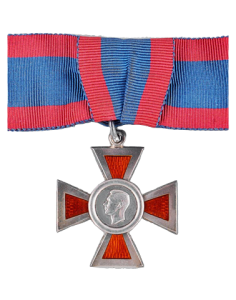
‘The King has been graciously pleased, on the advice of His Australian Ministers, to approve the appointment to be an additional associate of the Royal Red Cross, 2nd Class, in recognition of gallant and distinguished services whilst a prisoner of war in Japanese hands…’.
Marjory’s award was presented by the Governor of New South Wales at Government House, Sydney, on 6 December 1949. Our Royal Red Cross collection can help when researching military nurses awarded for their service.
The Grafton-based Daily Examiner offers further insight into Marjory’s wartime experience, quoting her award citation:
‘Nurse Anderson served in a camp hospital where she displayed outstanding devotion to duty and disregard of personal danger.
Together with five other nursing sisters, she was taken prisoner of war that month [January 1942] by the Japanese and interned in the Catholic Mission at Vanapope [sic Vunapope] (Kokopo, Rabaul) until 1, July 1942, when they transferred to Japan.
At Vanapope [sic Vunapope], nursing sisters were forced to live under shocking conditions in crowded and cramped quarters with inadequate and low quality diet.
In February 1942, they sought and obtained permission to attend sick A.I.F. personnel in a separate camp hospital until the hospital was closed in April, 1942.
Their conduct in adverse circumstances was in keeping with the highest traditions of nursing and was an inspiration to their patients.’
Marjory married Kenneth Morris-Yates in 1953 and died in 1994, aged 79, survived by her child, Allen.
Sources
Ancestry, Australia, Electoral Rolls, 1903-1980, accessed July 2023.
Anzac Portal, Fall of Rabaul, accessed July 2023.
Australian War Memorial, Fall of Rabaul, accessed July 2023.
Catherine Kenny, Captives: Australian Army Nurses in Japanese Prison Camps (Brisbane, Queensland, Australia: University of Queensland Press, 1987).
Concord Hospital, History, accessed July 2023.
Holocaust Encyclopedia, World War II in the Pacific, accessed July 2023.
New South Wales Government, Births, Deaths and Marriages search, accessed July 2023.
Newspapers.com, various articles, accessed July 2023.
The Australian Women’s Register, Australian Army Nursing Service (AANS) (1902 – 1948), accessed July 2023.

